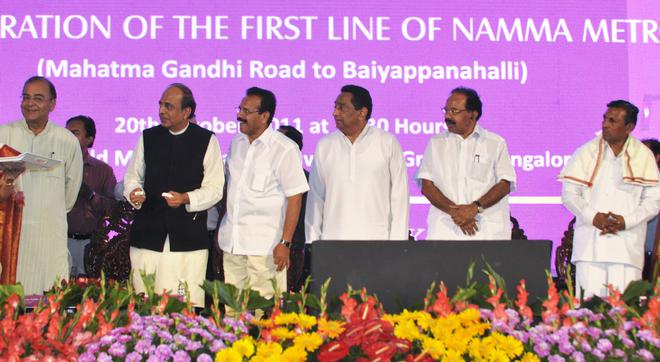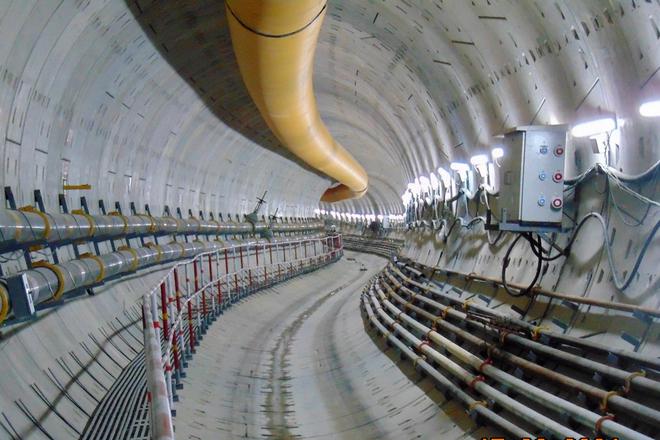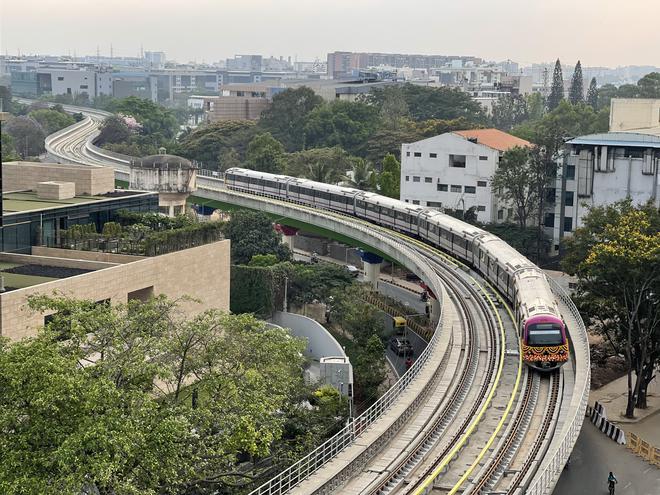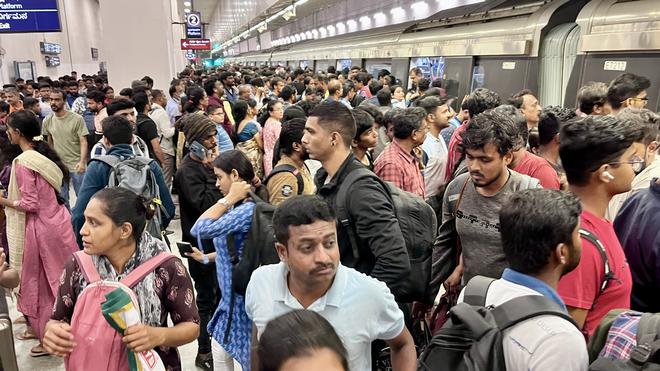:
Namratha Upadhya started her career as a business analyst at a private IT firm near Trinity Circle in 2011. Presently, she is Assistant Vice President-Risk and Compliance with the same company. Throughout her 12-year career, she has consistently travelled from Baiyappanahalli to Trinity Circle office on the Namma Metro. Her career milestone, she says, coincides with the 12th anniversary of the metro’s launch in the city, and she has an emotional connection with the rail network.
“I have been using it for the past 12 years. It is a lifeline for thousands of commuters like me. Seeing the entire Purple Line open is fulfilling. Though there have been multiple delays, seamless east-west connectivity is a significant achievement for the metro authority and Bengalureans,” she said.
Increase in ridership
The average daily passenger ridership of the Purple Line when it started in 2011 was 25,401. It’s now 6,01,432. The opening of the entire stretch has resulted in not only an increased number of passengers but also a reduction in traffic volume along the metro stretches, especially by 12% to 14% on Old Madras Road.
The Namma Metro project envisioned almost two decades before its launch, marked a significant leap in Bengaluru’s transport infrastructure. It was on October 20, 2011, that the first stretch (Reach 1 between Baiyappanahalli and M.G. Road) was opened.
On the 12th anniversary of Namma Metro last month, Prime Minister Narendra Modi inaugurated the entire 43.49 km stretch of the Purple Line from Challaghatta in the west to Whitefield in the east. Today, it’s India’s second-longest operational network, covering 73.81 km, after the Delhi Metro. It’s also South India’s first underground metro network.
A BMRCL official told The Hindu, “When the metro work began, many people protested against tree cutting. However, they are now among the metro commuters. As the city expands, we require vital infrastructure like the metro for seamless connectivity, benefiting all commuters.”

Completed and ongoing projects
Phase 1 of the project is complete, spanning over 42.3 km with 40 stations. It has two corridors: East-West (Purple Line) of 18.1 km and 17 stations, and North-South (Green Line) of 24.2 km with 24 stations. Both intersect at Nadaprabhu Kempegowda station (Majestic), an underground interchange station. Phase 1 was commissioned in stages from 2011, and the entire project was dedicated to the nation in June 2017.
In Phase 2, an eastern extension of 15.81 km with 13 stations, a western extension of 9.58 km with seven stations, and a southern extension of 6.12 km with five stations have been opened to the public. With this, the total operational length is 74 km.
Ongoing metro projects — the northern extension of 3.14 km with three stations and the new Reach 5 line (R.V. Road - Bommanahalli - Yellow Line), with a length of 19.15 km and 15 stations — are slated to be commissioned by April 2024. Also, the new line Reach 6 (Kalena Agrahara to Nagawara - Pink Line), covering 21.26 km with 17 stations, is scheduled for commissioning by March 2025, according to B.L. Yashavanth Chavan, Chief Public Relations Officer of BMRCL.
“The complete Phase 2 spans 75.06 km with 61 stations (49 elevated and 12 underground). With the completion of Phase 2 by 2025, the cumulative operational network will reach 117 km,” he added.
Phase 2A and 2B, the Outer Ring Road (ORR) - Airport Metro corridor, will cover 58.19 km with 30 stations. It is expected to be completed by June 2026, expanding the city’s operational metro network to 176 km.

Delays and missed deadlines
However, there have been numerous delays and unmet deadlines, which have inconvenienced the public for several years. Srinivas Alavilli, a public transport advocate in Bengaluru, said Namma Metro had misplaced its priorities. Constructing flyovers in places like Electronics City or the airport road before the metro rail raises questions, he said. According to him, metro construction should have been prioritised in these areas.
BMRCL officials attributed the delays to challenges in getting land from private individuals, the Forest Department, etc. An official told The Hindu, “PIL petitions filed against the BMRCL regarding felling of trees have also slowed our work.”
Expansion plans of metro
The Karnataka government has approved the construction of 317 km of metro lines under the Comprehensive Mobility Plan by 2031. A Detailed Project Report for Phase 3, covering 45 km at an estimated cost of ₹15,611 crore, has been submitted to the Government of India for approval. “A DPR for Phase 3A, from Sarjapura to Hebbal, spanning 37 km, is also under preparation. Feasibility studies will be undertaken for the remaining 60 km in due course,” Mr. Chavan said.
Phase 3 comprises two elevated corridors — one from J.P. Nagar 4th Phase to Kempapura along the Outer Ring Road (covering 12.5 km) and another from Hosahalli to Kadabgere along Magadi Road (spanning 32.15 km). This will include 31 stations, and the deadline is 2028.

Cost incurred
According to BMRCL, Phase 1 was constructed at a cost of ₹14,133.17 crore. With contributions of the Union and the State governments as equity and subordinate debts, nearly 45% of the amount is through senior debts from the Japan International Co-operation Agency (JICA), French agency Agence Francaise De Development (AFD) as pass-through assistance and also from Housing and Urban Development Corporation, Karnataka Urban Infrastructure Development and Finance Corporation, and bonds.
“Phase 2 of the project is estimated to cost ₹30,695 crore, with a nearly similar pattern of government funding, and the remaining funding through senior debts from AFD, EIB (the European Investment Bank), AIIB (Asian Infrastructure Investment Bank), and JICA, as pass-through assistance. Phase 2A and 2B, the ORR-Airport Metro corridor, is estimated to cost ₹14,788. The funding pattern is nearly similar. A part from the governments, and the remaining from senior debts from JICA and ADB as pass-through assistance,” Mr. Chavan explained.
Last-mile connectivity issues
While the metro has now become the first choice of commute for lakhs of people, the first and last-mile connectivity remains a major issue. Experts say it’s important to resolve this to realise the full potential of the metro network.
In collaboration with the World Resources Institute, the Bangalore Political Action Committee initiated the #Personal2Public campaign to discourage people from taking their personal vehicles. As part of this, the Bengaluru Metropolitan Transport Corporation introduced feeder bus services to connect prominent tech corridors, such as the one on Outer Ring Road, with metro stations.
Supplementing the services of apps like Uber, Ola, Rapido, and Namma Yatri is the Metro Mitra app, a collaborative initiative between the BMRCL and the Autorickshaw Drivers Union to address the last-mile connectivity problem.

Overcrowding of metro coaches
With the metro network expanding, another problem is the overcrowding of the six-coach trains. During peak hours, long queues at metro stations and commuters unable to board the crowded coaches have become a common sight. This is despite trains running at three-minute intervals during peak hours.
Metro train service frequency on the Whitefield (Kadugodi) - Pattandur Agrahara section is 10 minutes, and on the Pattandur Agrahara - Mysuru Road section is five minutes. During morning peak hours, the frequency on the Nadaprabhu Kempegowda Station - Majestic - M.G. Road section is three minutes, and between Mysuru Road and Challaghatta is 10 minutes. Commuters want the frequency to be increased.
BMRCL officials said the frequency can be increased only after they get new coaches. Currently, BMRCL operates a total of 57 trains, with 33 serving the Purple Line and 24 allocated to the Green Line. A BMRCL official said, “The frequency of trains will be increased according to demand, and efficient crowd management strategies will be implemented at the stations. The primary solution to reduce overcrowding is to add more train coaches.”







